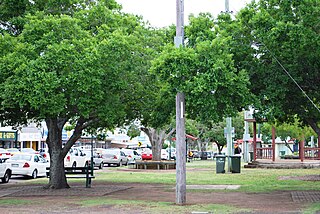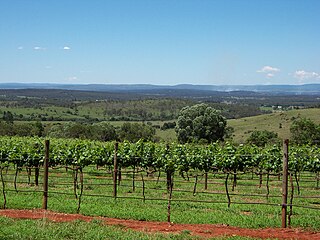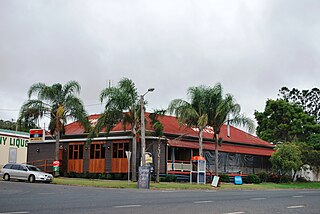
Kingaroy is a rural town and locality in the South Burnett Region, Queensland, Australia. The town is situated on the junction of the D'Aguilar and the Bunya Highways, 218 kilometres (135 mi) north-west of the state capital Brisbane and 141 kilometres (88 mi) south west of Gympie. In the 2021 census, the locality of Kingaroy had a population of 10,266 people.

Murgon is a rural town and locality in the South Burnett Region, Queensland, Australia. In the 2016 census, the locality of Murgon had a population of 2,378 people.

Kilkivan is a town and locality in the Gympie Region of Queensland, Australia. At the 2016 census, Kilkivan had a population of 713.

Goomeri is a rural town and locality in the Gympie Region, Queensland, Australia. In the 2016 census, the locality of Goomeri had a population of 664 people.

The South Burnett is a peanut growing and wine-producing area on the Great Dividing Range, north of the Darling Downs, in Queensland. It is with the basin of the Burnett River. The area is within two local government areas, South Burnett Region and Gympie Region.

Tingoora is a rural town and a locality in the South Burnett Region, Queensland, Australia.

Wooroolin is a rural town and a locality in the South Burnett Region, Queensland, Australia.
Theebine railway station is a closed railway station on the North Coast railway line of Queensland, Australia at Theebine. Slightly south of the railway station is the junction between the main North Coast line and the Kingaroy branch, which continues into west Queensland. It is also the junction for the Dickabram line.

Theebine is a rural town and locality split between the Gympie Region and the Fraser Coast Region, both in Queensland, Australia.

Woolooga is a rural town and locality in the Gympie Region, Queensland, Australia. In the 2016 census the locality of Woolooga had a population of 247 people.

The Nanango railway line was a narrow-gauge branch railway located in Queensland, Australia. On 31 October 1882, parliament approved the construction of a branch line from Theebine west to Kilkivan after gold and copper were discovered in this region of Queensland, Australia. The section was opened in two stages – to Dickabram on 1 January 1886 after two crossings of the Mary River and to Kilkivan on 6 December 1886.

Wide Bay–Burnett is a region of the Australian state of Queensland, located between 170–400 km (110–250 mi) north of the state capital, Brisbane. The area's population growth has exceeded the state average over the past 20 years, and it is forecast to grow to more than 430,000 by 2031. It is the subject of the Draft Wide Bay–Burnett Regional Plan, which aims to facilitate this growth while protecting over 90% of the region from urban development.

Elgin Vale is a rural locality in the Gympie Region, Queensland, Australia. In the 2016 census, Elgin Vale had a population of 24 people.

Miva is a locality split between the Gympie Region and the Fraser Coast Region in Queensland, Australia. In the 2016 census Miva had a population of 57 people.
The Kilkivan to Kingaroy Rail Trail is an 88-kilometre (55 mi) recreation trail from Kilkivan to Kingaroy. The trail follows the old Kingaroy Branch railway and is open to walkers, cyclists and horse riders.

Kinbombi is a rural town and locality in the Gympie Region, Queensland, Australia. In the 2016 census, the locality of Kinbombi had a population of 37 people.

Manumbar is a rural locality in the Gympie Region, Queensland, Australia. In the 2016 census, Manumbar had a population of 53 people.

Tansey is a rural town and locality in the Gympie Region, Queensland, Australia. In the 2016 census, Tansey had a population of 144 people.
Goomeribong is a rural locality in the Gympie Region, Queensland, Australia. In the 2021 census, Goomeribong had a population of 49 people.
Black Snake is a rural locality in the Gympie Region, Queensland, Australia. In the 2021 census, Black Snake had a population of 88 people.



















